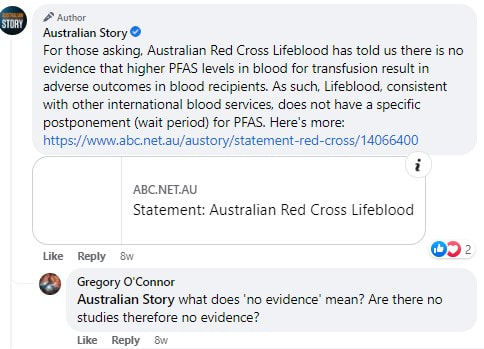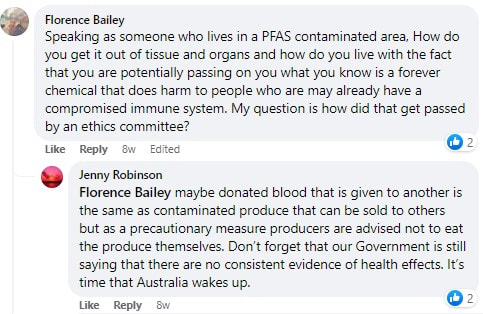pfas donated blood
ABC Australian Story featured an episode about Victorian firefighters with high PFAS levels in their blood using blood and plasma donations as a way to reduce their PFAS levels - INSIDE FISKVILLE FIREFIGHTER CANCER CLUSTER AND THE PEOPLE WHO EXPOSED TOXIC FOAM.
The research paper is - Effect of Plasma and Blood Donations on Levels of Perfluoroalkyl and Polyfluoroalkyl Substances in Firefighters in Australia - A Randomized Clinical Trial
PFAS attaches to proteins which is found in blood. So, if you're donating blood, you're also discharging proteins; the same thing with plasma. While the project outcome was successful for the firefighters it was the fact Australian Red Cross Lifeblood then went on to use the contaminated blood for either blood transfusion or plasma products that became topical.
The caption Red Cross provided for the story are dismissive and not credible.
- there is no evidence that higher PFAS levels in donated blood adversely affect recipients.
The research paper is - Effect of Plasma and Blood Donations on Levels of Perfluoroalkyl and Polyfluoroalkyl Substances in Firefighters in Australia - A Randomized Clinical Trial
PFAS attaches to proteins which is found in blood. So, if you're donating blood, you're also discharging proteins; the same thing with plasma. While the project outcome was successful for the firefighters it was the fact Australian Red Cross Lifeblood then went on to use the contaminated blood for either blood transfusion or plasma products that became topical.
The caption Red Cross provided for the story are dismissive and not credible.
- there is no evidence that higher PFAS levels in donated blood adversely affect recipients.
What does the science say
There was only one science paper found online about blood donations with pollutants - Environmental pollutants in blood donors: The multicentre Norwegian donor study.
Background: Transfused blood may be a potential source of exposure to heavy metals and organic pollutants and presents a risk to vulnerable patient groups such as premature infants.
...PFAS concentrations and heavy metal concentrations increased with donor's age.
Conclusion: A considerable percentage of donors had lead, PFOS and PFOA concentrations over the suggested limits. In addition, at each study site, there were donors with high mercury and cadmium concentrations. Selecting young donors for transfusions or measurements of pollutants in donor blood may be a feasible approach to avoid exposure through blood transfusions to vulnerable groups of patients such as premature infants.
...During blood transfusions, pollutants present in the donor's blood are transferred to the recipients. Transfused blood, as well as blood components, may represent a substantial source of environmental pollutant exposure for the recipients, particularly for vulnerable groups such as premature infants who receive multiple blood transfusions. Blood transfusions were shown to increase heavy metal concentrations in premature infants.
Background: Transfused blood may be a potential source of exposure to heavy metals and organic pollutants and presents a risk to vulnerable patient groups such as premature infants.
...PFAS concentrations and heavy metal concentrations increased with donor's age.
Conclusion: A considerable percentage of donors had lead, PFOS and PFOA concentrations over the suggested limits. In addition, at each study site, there were donors with high mercury and cadmium concentrations. Selecting young donors for transfusions or measurements of pollutants in donor blood may be a feasible approach to avoid exposure through blood transfusions to vulnerable groups of patients such as premature infants.
...During blood transfusions, pollutants present in the donor's blood are transferred to the recipients. Transfused blood, as well as blood components, may represent a substantial source of environmental pollutant exposure for the recipients, particularly for vulnerable groups such as premature infants who receive multiple blood transfusions. Blood transfusions were shown to increase heavy metal concentrations in premature infants.
what does Australian red cross lifeblood have to say
Red Cross provided a statement the following day due to community uproar but Red Cross has not provided any research studies to back up their statement, "there is no evidence that higher PFAS levels in donated blood adversely affect recipients."
What this highlights is the ongoing refusal by health authorities to tell the truth, use credible and updated international research and advice, not what the government says just because it pays the bills.
In the past, Red Cross had a lot to say about PFAS, naming high exposure groups, donating blood and giving PFAS advice that we now know is incorrect. But Red Cross starting changing comment about what professions were exposed to then give a one liner.
The Australian Story controversy forced Red Cross into providing a new PFAS fact page which continues the same shameful outdated dribble. This is nothing more than a health service lying by omission of the facts.
The Australian government fully fund Red Cross for the provision of blood products and services to the Australian community.
Yes, you can. Per- and poly-fluoroalkyl substances, also known as PFASs, are a group of manufactured chemicals that have been used since the 1950s in a range of common household products and specialty applications, including in the manufacture of non-stick cookware, fabric, furniture and carpet stain protection applications, and more.
What this highlights is the ongoing refusal by health authorities to tell the truth, use credible and updated international research and advice, not what the government says just because it pays the bills.
In the past, Red Cross had a lot to say about PFAS, naming high exposure groups, donating blood and giving PFAS advice that we now know is incorrect. But Red Cross starting changing comment about what professions were exposed to then give a one liner.
The Australian Story controversy forced Red Cross into providing a new PFAS fact page which continues the same shameful outdated dribble. This is nothing more than a health service lying by omission of the facts.
The Australian government fully fund Red Cross for the provision of blood products and services to the Australian community.
- The 2016 fact sheet - Per- and poly-fluoroalkyl substances and blood donation is a 2 page document.
- The 2017 fact sheet is now a one page document.
- As of 30 October 2022, there is no longer a document PDF but a one liner to this question - WayBack Machine link to highlight the change.
Yes, you can. Per- and poly-fluoroalkyl substances, also known as PFASs, are a group of manufactured chemicals that have been used since the 1950s in a range of common household products and specialty applications, including in the manufacture of non-stick cookware, fabric, furniture and carpet stain protection applications, and more.
- Then, on 16 November 2022 Red Cross added a little red link button to a new PFAS information page. The is one sentence change though - Lifeblood does not have a specific deferral for PFOS or PFOA. We do not have a program for venesection to decrease PFAS levels and are not accepting referrals through our therapeutic app.
|
Page last updated 25 November 2022
|




